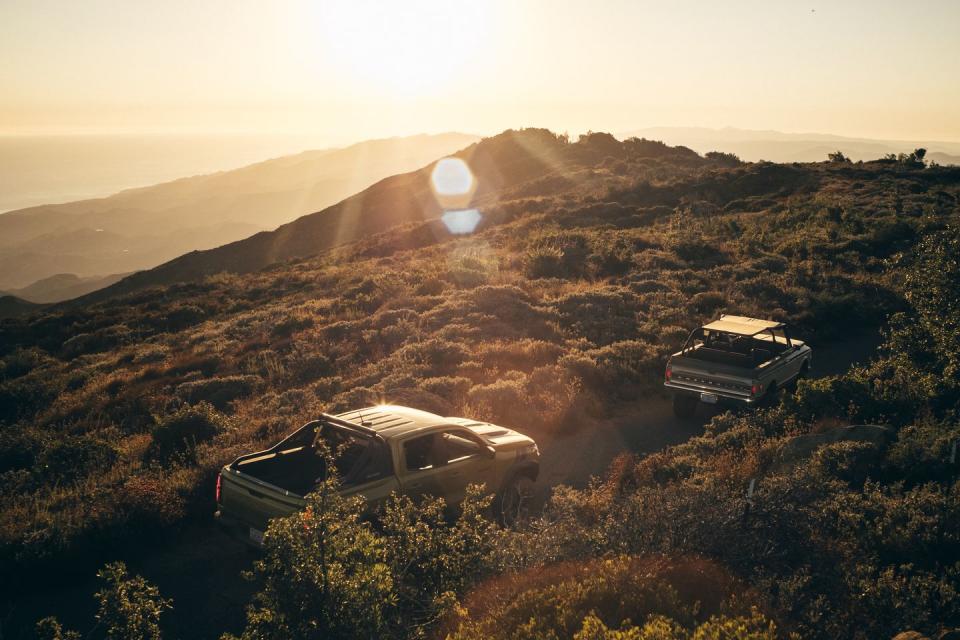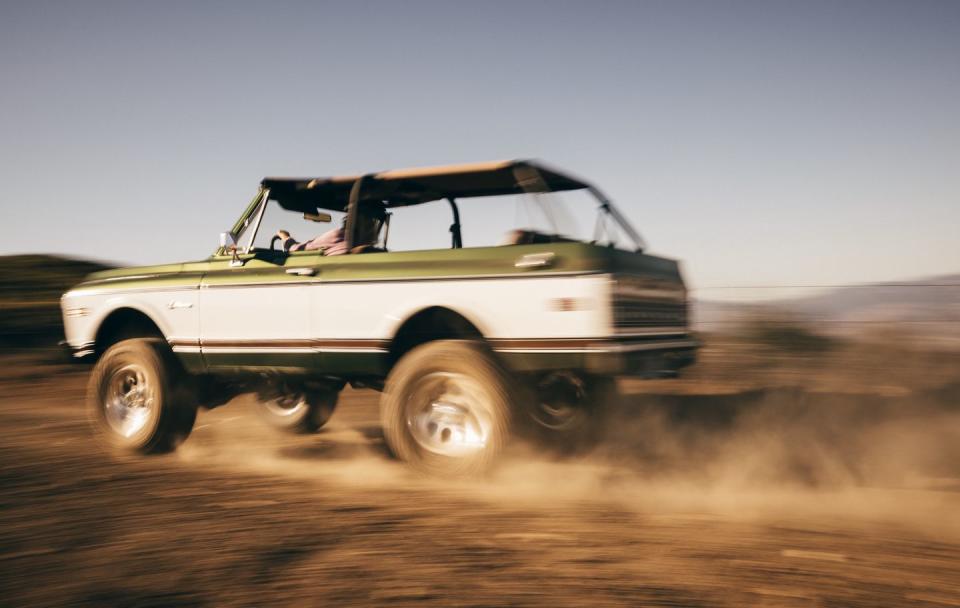Velocity 1970 Chevrolet Blazer and Colorado ZR2: Chevy's Greatest Off-Roaders


It was America’s favorite vehicle for beer runs to the lake. The good times, good friends, good vibes 4x4. Utility vehicles had been around for decades; this is the one that added “sport” to the equation. Chevrolet’s ads pushed it as a practical truck for far-flung enterprises that extended past where roads dared go. But no one believed that. The original 1969 K/5 Blazer was about fun.
And five and a half decades later, it’s on the Mount Rushmore of Great American Moving Things next to the stagecoach, riverboat, and 747. It narrowly beats the steam locomotive and easily transcends all muscle cars and every Harley-Davidson. Corvettes are polarizing. Mustangs can’t haul a party. But everyone, everybody and every American loves the first-generation (1969-1972) K/5 Blazer. Don’t argue with America.

Here are two branches of the K/5 legacy. The glorious one is the Velocity Restorations 1970 Blazer refinished to blinding brilliance, riding on a new chassis, and powered by a 6.2-liter GM LT1 crate engine that Velocity rates at 460 horsepower. The new one is Chevy’s latest 2024 Colorado ZR2 pickup -- great, great grandchild of the K/5. Packed with tech unimagined by mid-20th century humanity. It’s spookily easygoing. And it’s 2.7-liter, turbocharged, four-cylinder engine is SAE net-rated at 310 horsepower. That’s 55 ponies more than the gross-rated, carb-fed 5.7-liter V-8 offered as the K/5’s top engine in 1970.
Velocity 1970 K5 Blazer
Crowds don’t admire the Velocity Blazer from afar; they flock to it. With its green and white two-tone paint, brilliant chrome and shiny grille, it’s the K/5 as people imagine it to be. This one is much nicer and better than how the old Blazers were experienced during the Seventies and Eighties. Back in the day, these things were beat to death.
Velocity starts with a donor K/5 and replaces so much of the metal that all the body panels actually align with one another (not General Motors’ usual Seventies practice). And the paint is utterly luscious. The flaws that remain were built in by GM. The panel gaps are huge, the trim pieces are pretty from afar but chintzy up close, and the doors shut like, well, Sixties GM doors. Velocity has a (Yeow!) $402,100 price tag on this beast (up from a $339,900 base), but GM was selling hundreds of thousands full-size trucks every year. And selling them cheap. GM designed the Blazer to be thrown together quickly and inexpensively. That it’s as gorgeous and as stout as it is, counts as a miracle.

Under the ruggedly luscious sheetmetal, Velocity fits an all-new chassis from The Roadster Shop. There are still two solid axles (serious off-roaders favor them), but in place of the original leaf springs there are now four-link systems front and rear. Using coil springs and Fox Racing remote reservoir shocks, the ride motions are vastly more supple than the original K5 on-road without apparently sacrificing off-road ability.
While the Velocity K5’s suspension is vastly improved, what may go under-appreciated is how much stouter the frame is than stock. Roadster Shop builds its frames around thick-wall, fully boxed, 5.0 x 2.5-inch steel rails. That’s in stark contrast to the thin metal, open channel rails that made up the stock frame. This new chassis is a more stable and obviously more robust base upon which to build a truck. And the increased torsional rigidity means that the chassis isn’t flexing as much under the body. That means precise suspension location and it should reduce squeaks and rattles over time.

Getting into this K5 is facilitated by the AMP Research power steps that drop down when a door opens. This is, after all, a big truck riding on 35-inch Toyo Open Country M/T tires on 18-inch, six-lug aluminum alloy wheels. It’s not lifted much over stock, but it’s up there.
GM didn’t build any luxury into the K5. Velocity has managed to add some comfort without betraying the original hose-it-out design. There’s some implausible phony wood surrounding the instrumentation. And it is real instrumentation – gauges from Dakota Digital and not a screen – that looks classic without looking old.
The seats come from Procar. You get a six-point roll cage just in chase, and surely a top could be fitted. It’s all ridiculously nice, even if it’s primitive compared to modern machinery.

GM’s LS- and LT-Series of Small Block V-8s are miracles of compact, overhead valve, two-valves per cylinder engineering. So, the LT-1 is almost lost in the vast cavern of the Blazer’s engine bay. And without many of the electronic equipment embedded in newer trucks – like ABS, radar sensors, sundry intercoolers – it’s a neat and clean installation. It should be easily serviced even by the most clam-fisted dealership technician.
But the best part of the LT1 is the power it delivers. It’s a sweet wave of torque that never hiccups or barfs. It’s light years better than anything GM offered in the K5 and imparts an athleticism to the truck that’s almost astonishing. And it matches well with the vastly improved chassis behavior and steering.

Behind the LT1, Velocity fits GM’s current 10L80 ten-speed automatic transmission. There’s nothing wrong with how the 10L80 operates, but that many gears are overkill in this application. The point of having all those cogs is to ace the EPA driving cycle and squeeze every drop of fuel economy out of GM’s production vehicles. That doesn’t apply in a restomod beast. One of GM’s older six- or even four-speed automatics would likely be as easygoing as the ten-speed.
Shifting into four-wheel drive is easy in the Velocity Blazer, but engaging the front wheels means getting out of the truck and twisting the manual locking hubs. It’s not that big a deal for most off-roaders and oddly charming, but it may seem primitive to anyone used to more modern systems. Certainly we are not engaging our lockers via a touch screen, as you would in a new Land Rover.

Surefooted and muscular, the Velocity Blazer easily handled the mild off-roading challenges available in hills above Santa Barbara, California. The Toyo tires are grippy, the mechanicals don’t grind or bind, and the interior is a happy place to be on a sunny day. It drives incredibly well, even as the vast steel hood flutters as the wind passes over it. Just like almost every large GM truck for more than half a century did.
Yeah, it’s a lot of money. And all the pieces that are the substance of the Velocity Blazer could be bought separately. What the bucks cover are experience and development. Velocity knows how to assemble all the parts so that it operates as an integrated whole. They’ve done this before.

That amounts to product development. Little appreciated by many who clog up Barrett-Jackson auctions, restomod vehicles are all development projects. It's maybe not to the extent of a new production vehicle, but it’s still a lot of work. Freelancing assembly of all the parts on your own may be tempting, and maybe even save some money, but it’s a risk. And if you have $400,000 to spend on an old Blazer it’s safer to spend that with a company that’s done similar work before. Saving, say, $100,000 on initial assembly could be satisfying, but nothing could be more frustrating than watching those savings vanish fixing what goes wrong.
More than 50 years of advancement in production engineering mean that builds the Colorado ZR2 better than it ever built the Blazer.

2024 Chevrolet Colorado ZR2
Accompanying the Velocity Blazer on this short adventure was Chevy’s latest dirt runner, the Colorado ZR2. There are lessons the tech-heavy ZR2 could learn from the Velocity K5, like the virtues of simplicity. But the big question that arises is this: Why isn’t Chevy building a 21st-century K5 based on this truck? It's GM leaving money on the table.
All the plumbing in the Colorado’s engine bay is daunting, but the turbocharged 2.7-liter four delivers torque from just off idle and is almost as sweet as the LT1 from the Velocity Blazer in operation. It doesn’t have that seductive V-8 exhaust note, it isn’t quite even V-6 smooth, and working around all that plumbing will take some deep spelunking, but it’s effective.

The new-in-2023 Colorado ZR2 rides on a 2.9-inch longer wheelbase than the previous version and that does two important things. It allows fitment of larger tires – the Goodyear Wrangler Territory Mud Terrain tires stand 33-inches tall – and it soothes the ride. The old Colorado ZR2 was a jouncy thing that felt as if it were ready to hop over a couple lanes if it hit a freeway expansion joist just so. This is a far more settled machine and that makes it much easier in daily use.
But it’s off-road where it shines bright. Using Multimatic’s DSSV super-shocks and with 9.9-inches of travel in front and 11.6-inches in back, it scrambles over rocks and crags with utter confidence. It is, by far, the most nimble and capable off-roader that General Motors has yet built.

There are five different electronically-selectable drive modes in the ZR2. To effectively experience all of them would mean traveling to several venues and waiting for crappy weather in several of them. For the most part, however, the ZR2 works great even when left in “Normal” for both on- and off-road adventuring.
“Off-Road” mode was great in light off-roading. But this trip never encountered anything close to needing the “Terrain” setting for rock crawling or “Baja” for overwhelming sandy stretches. And, well, there was never any reason to use the “Tow/Haul” mode either.

The Colorado ZR2 is thoroughly modern inside with loads of digital instrumentation and power seats and all sorts of things that wouldn’t respond well to being hosed out. There’s an argument to be made that Chevy would be well served by taking out some of the tech and selling the ZR2 in a simpler form. And maybe knocking some cost out of the $48,790 base price (including a $1595 destination charge).
With Ford selling Broncos, Jeep still hawking Wranglers and every brand seeming to retailing boxes with big tires, why has Chevy left the Blazer brand to molt on conventional and electric crossovers? It has the right pieces sitting right there on the Colorado. If the Velocity K5 is anything to go by, the people are yearning for one.
You Might Also Like

 Yahoo Finance
Yahoo Finance 